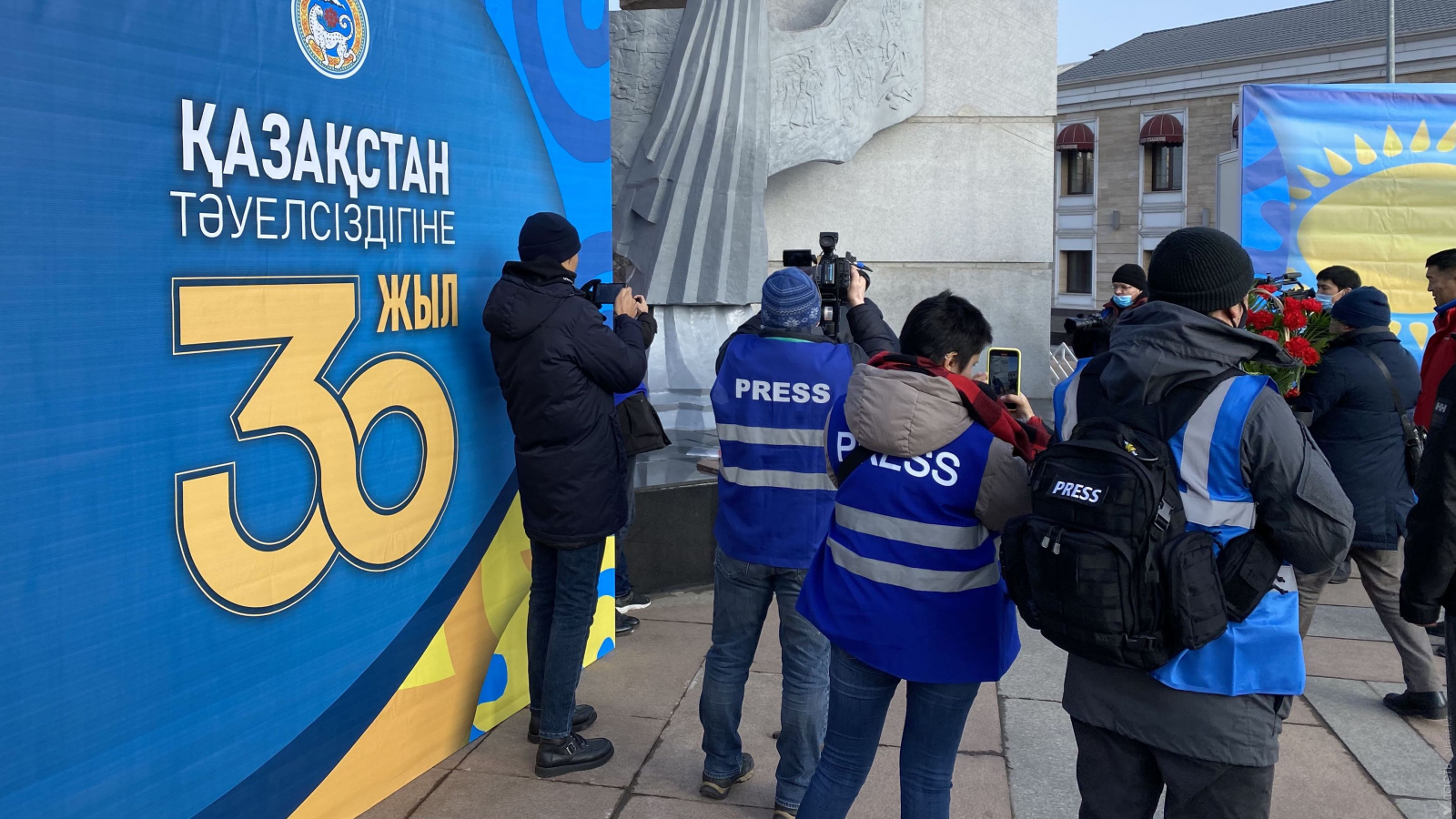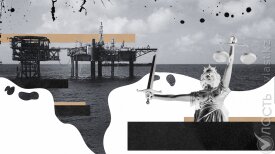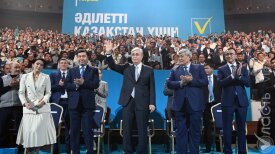In 2022, Adil Soz, a foundation for the defense of freedom of speech, recorded 32 incidents of attacks against journalists in Kazakhstan. This number is four times higher than in the previous year. And since Qandy Qantar (Kazakh for ‘Bloody January’, the violent repression of urban protests of January 2022), attacks have become even more frequent.
Journalists and experts said the current situation resembles the era of former President Nursultan Nazarbayev. There seems to be little support from the state, which has stalled the search for the perpetrators of the attacks. More violence could now be on the horizon.
Attacks Become More Frequent
In 2023, attacks and threats against journalists have reached a new level. “Just in the first month, we recorded at least seven incidents. These journalists were targeted for their professional activity,” Karlygash Jamankulova, head of Adil Soz, told Vlast.
In mid-January, unidentified individuals set fire to Dinara Yegeubayeva’s car. Yegeubayeva regularly criticized the government’s decisions, and has applied to run for a seat in parliament with the civic coalition Altynshy Qantar (Kazakh for “January 6”). A few days later, journalist Vadim Boreiko, host of the Giperborei YouTube channel, reported that three young men tried to block the door to his apartment in Almaty.
Boreiko said he received threats already in September, ahead of the announcement of early presidential elections. At the time, an acquaintance called Boreiko to relay the words of an unnamed ‘silovik’ (a person in or close to law enforcement structures): If the journalist avoided mentioning President Kassym-Jomart Tokayev for the next two months, he would receive monetary compensation.
“This was definitely a way to see if I would fall for a bribe. This is how they generally deal with independent journalists. First they negotiate ‘in a nice way’, then they try with a bribe, then they try to discredit you, and then they move onto intimidating you,” Boreiko told Vlast in an interview.
Boreiko could not say who plotted the latest attack, although he said that so many incidents in such a short period could indicate coordination.
Political analyst Dosym Satpayev fielded three possible hypotheses to explain the current situation. First, the attacks could be organized by people close to Nazarbayev to discredit Tokayev’s image. Second, the pressure on journalists could be beneficial for Tokayev to keep them in check and at the same time purportedly act as a guarantor of their security. The third hypothesis is based on the suspicion that the Russian government could be coordinating attacks on Kazakhstani media and journalists who have supported Ukraine’s position in the war.
International lobby groups for media freedom are calling the government to investigate the incidents and ensure a punishment for the perpetrators and those behind them.
Marius Fossum of the Almaty branch of the Norwegian-Helsinki Committee, a human rights organization, thinks these attacks on journalists could represent a warning sign to other members of the press to scare them away from covering topics such as corruption.
In addition, Fossum told Vlast that the discourse about a “New Kazakhstan” is pointless if such attacks against independent journalists go unpunished.
Jeanne Cavelier, head of Eastern Europe and Central Asia desk at Reporters Without Borders, also expressed concern about the ongoing attacks: “There is a high level of impunity in the country, despite president Tokayev's official statements on his willingness to fight violence against journalists. These abuses should stop,” Cavelier wrote in an email to Vlast.
In a statement, Gulnoza Said, of the Committee to Protect Journalists media watchdog, highlighted how harassment has increased in frequency, despite promises of change.
Representatives of US, British, and EU countries’ diplomatic missions all shared words of support for the journalists victims of the latest attacks. They also welcomed Tokayev's statement about the need for a thorough investigation into all incidents.
Insecurity Is the Norm
Speaking to Vlast, Boreiko noted that these instances of violence are reminiscent of the Nazarbayev era. He recalled the shutting down of the Respublika opposition newspaper in 2012.
“At the time, they set fire to the editorial office, hung a dead dog outside their window. But I don’t remember such a massive campaign directed against several media outlets and individual journalists,” Boreiko said.
Between the 1980s and 1995, Kazakhstan enjoyed relative freedom in the media sphere, according to the veteran journalist. Then, after the “second Nazarbayev Constitution”, violence and censorship became commonplace.
Between 2000 and 2015, Adil Soz counted at least 250 incidents against the media in Kazakhstan.
In 2000, Aktobe journalist Dulat Tulegenov died after falling out of a window on the fourth floor of a building. Just before his death, which was never properly investigated, he published an article about allegations of abuse of power by local officials.
Only between January and February 2009, three violent incidents took place. Radio Azattyq’s editor Yermek Boltai was beaten and suffered a concussion and minor injuries; Bakhytzhan Nurpeissov, a correspondent for independent newspaper Public Position, was beaten by five aggressors in Almaty, suffering a head injury; Artem Miusov, journalist working for the Taszhargan newspaper, was stabbed and severely injured.
In 2012, in Uralsk, journalist Lukpan Akhmedyarov was attacked and stabbed. Later that same year, Ularbek Baitalak, a freelance journalist writing for opposition newspapers, was beaten up in Astana.
Between 2015 and 2020, attacks against journalists became less frequent. Fewer than 10 attacks were recorded annually. Instead of physical attacks, pressure on the media took the form of fines and criminal prosecution.
In 2016, Nakanune and Pravdivaya Gazeta, two small newspapers, were shut down after being given large fines. In 2017, then-editor of the Tribuna newspaper Zhanbolat Mamai was jailed for seven months on charges of money laundering. Financial trouble and pressure also led to the closure of Radiotochka in 2017. The following year, a court ordered the shutting down of Ratel.kz, an online media (the decision was later overturned).
Attacks during and after Bloody January
Attacks against journalists and media continued throughout 2021, but January 2022 represented a significant escalation of violence. During the clashes of Qandy Qantar, in fact, more than 50 episodes of physical attacks on journalists were recorded. Muratkhan Bazarbayev, a TV channel operator, was killed; Bek Baitas, a journalist for Orda.kz was wounded; Amangeldy Batyrbekov, chief editor of Saryagash News, was a victim of an attempted murder.
On January 7, at the height of the violence of Bloody January, Tokayev said in a speech that “The so-called ‘independent’ mass media [have played] an accessory role and, in some cases, an inciting role in violations of law and order.” According to Satpayev, the political analyst, this was a turning point that led to the surge of violent pressure against journalists.
Attacks resumed in July last year, when Olesya Vertinskaya, a journalist for the publication Road Control, was beaten near her home in Aktau. She was warned days before the incident not to write about a certain company. Her colleague Anton Knyazev was also beaten just a few weeks later.
Adil Soz recorded 40 instances of threats against journalists in 2022. The windows of the business center where El Media has its headquarters in Almaty were repeatedly broken with bricks. Orda.kz received a number of threats either spray painted outside their office or delivered in the form of a severed pig’s head in a package. The chief editors of both publications have repeatedly denounced receiving threatening phone calls.
Digital attacks are yet another tool of pressure. Adil Soz recorded more than 40 Distributed Denial of Service (DDoS) attacks on media websites, at least 6 instances of authorities blocking internet resources, and at least 11 denials of access without warning.
In 2022, dozens of journalists were detained or summoned by the police. And while most of these instances occurred during Qandy Qantar, in some cases they seem specifically targeted. In December, Vremya journalist Mikhail Kozachkov was arrested for extortion. He claims the charges against him are trumped up and politically motivated.
More Violence ahead?
The legal infrastructure in Kazakhstan is not ready to bring justice for these attacks against journalists, argues Satpayev.
Against the backdrop of constant delays in the justice system, Tokayev publicly urged law enforcement to thoroughly investigate these instances of violence against the press in two occasions. On January 20, he added that not only the perpetrators, but the masterminds too should be apprehended.
Minister of information Darkhan Kydyrali often wrote words of support and concern regarding the various attacks against the press on his Facebook page, although notably failing to mention the incidents involving Yegeubayeva and Boreiko.
Kanat Iskakov, head of the information committee at the ministry, told Vlast that an attack against journalists is an attack against the state and the entire society. According to him, the ministry closely collaborates with law enforcement officials to monitor and give support during these incidents.
“We are constantly in touch with the journalists that have suffered violent attacks, whether they have filed a complaint or not. We are also interested in a rapid reaction to these incidents,” Iskakov said.
Boreiko disagrees.
“Nobody from the ministry contacted me. None of them offered any kind of support. In 2018 we even saw that it actually works the other way around: The ministry was on the side of the prosecution, when the court ordered the shutting down of Ratel.kz.”
Jamankulova of Adil Soz added that, besides lacking support, journalists are also at a disadvantage for what concerns the law. “Article 158 of the Criminal Code is supposed to protect the rights of journalists. Unfortunately, over the past three decades, this was invoked only twice in court.”
Neither Nazarbayev, nor Tokayev created an infrastructure for the security of society, argued Satpayev, highlighting how this has a negative impact on the safety of journalists. The system is created to protect the ruling elite, said the political scientist, against journalists and civil society alike.
Satpayev speculated that the latest attacks against journalists could be aimed to creating a controlled tension.
This dynamic could spiral into further violence and its normalization, Satpayev concluded.
Should the government fail to push for a thorough investigation of these attacks, it will carry the responsibility in the eyes of society and the international community, Jamankulova told Vlast.
“The touted political reforms will be questioned, as well as Kazakhstan’s international position. Worsening indicators in the press freedom rankings, in fact, have a negative effect on the country’s diplomatic as well as trade opportunities.”
Cavelier, of Reporters Without Borders, clarified one final point about their World Press Freedom Index. While Kazakhstan has jumped upwards in the ranking last year, “we have not seen any improvement, this is due to the new methodology and the ranking of other countries.”
Поддержите журналистику, которой доверяют.








